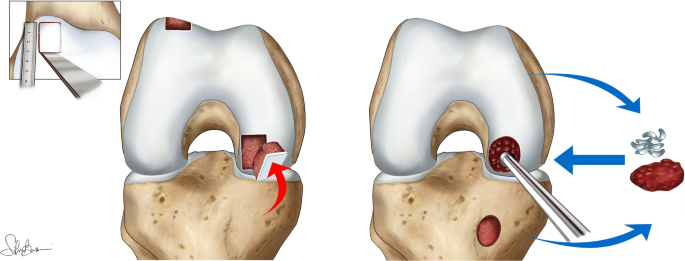Osteochondral Autograft Transfers (OATS)
Cartilage is a semi-rigid, flexible connecting tissue surrounding joints. They envelop the ends of the bones and providing cushion-like support to joint bones. When there is loss of this construct this is called a Chondral Deffect. This is a painful condition and is the debility representing with different name in different condition. These can be a spectrum from single focal defect to advanced multifocal loss. It gets its nourishment from the synovial fluid supported by knee motion. It has poor blood supply. It is supported by underlying bone for this, thus the osteochondral unit makes it functional entity. Losing contact from underlying bone turn it non viable tissue. Cartilage has poor self healing power so it requires special care and technique for the injury management.
Osteochondral Autograft Transfers (OATS) is a technique of harvesting cylindrical osteochondral (bone and cartilage) unit from healthy non- weight bearing area of the joint. This is called as Donor area. Tight press fit the same in the created cylindrical defect over painful weight bearing region called as Receptive area. When multiple plugs are harvested, then this is called as Mosicoplasty.This procedure is done for cartilage lesions from 1.5 cm2 to 4 cm2 that have failed microfracture surgery or abrasive arthroplasty. The major limitation of oats is the amount of the harvestation osteochondral tissue from the patient’s own knee. So this procedure is not suitable for larger lesion more than 4 cm2.
Osteochondral Allografting- Here in this technique the chunk of the articular cartilage along with underlying subchondral bone from the donor cadaveric bone end is transplanted tight press fit the same in the created cylindrical defect over painful weight bearing region called as Receptive area ,(the damaged concerned lesion of the articular osteochondral joint surface). The use of donor bone tissue is necessary when the recommended lesions are 4cm2-10cm2. The aim of this technique is to replenish the healthy viable chondrocytes along with supporting subchondral bone. This gives a stable support for the viability of the articular cartilage matrix. This thereby relieves the pain. By this the whole damaged cartilage is replaced by healty surface. This trick prolongs the joint survivability and durability and delay or postponed major final total replacement for many healthy active years. A potential concern with the use of donor tissue (Allograft) is the very low risk of disease transmission (similar as in a blood transfusion).

Post operative protocol of Osteochondral Autograft Transfers
Patients is observed for 4-6 weeks of surgery and usually allowed to bear weight thereafter. This is followed by gradual increase in the active exercise. The return to the sports activity is allowed after 6 -9 moths.
Patients often recover from both of these procedures. Basic idea of both of this surgical technique is to replace damaged healthy tissues.
This is a subject of judicious thorough understanding of the patient individual case scenario. Joint preserving orthopaedic surgeons do this job diligently. Ignorance and casual attitude may worsen the condition. Such conditions if not addressed in right time may end in irreversible disability even under trained hands of best doctor for knee preserving/ knee replacement in Delhi or best orthopaedic doctor in India.
Contact Us
- Orthopedic clinic JMC Hospital, Joshi Rd, Block 63, Karol Bagh, New Delhi, Delhi 110005
- +91 8595471202
- drrajeshbhalla@yahoo.com
